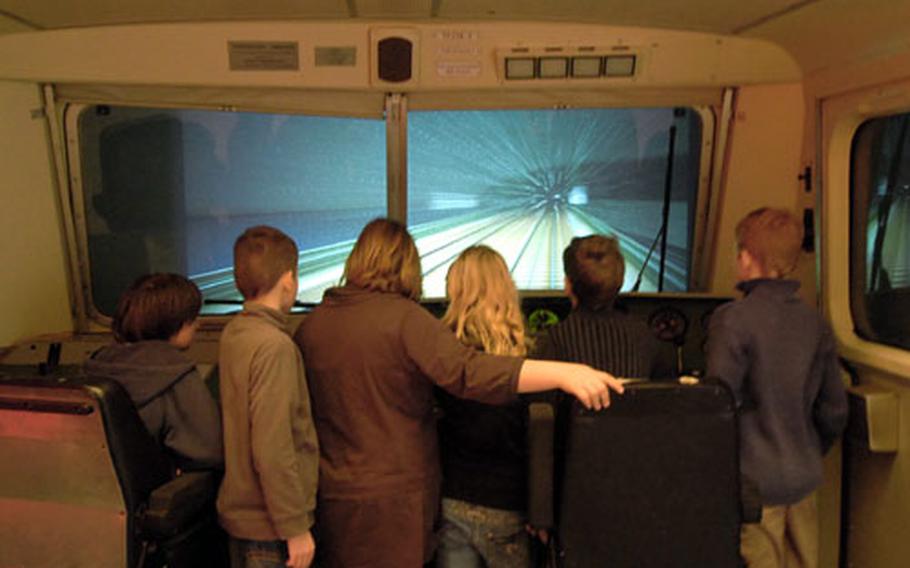
Visitors try their hand at being an engineer on a simulator at the DB Museum. (Michael Abrams / S&S)
Boys of all ages supposedly have a certain fascination with trains. Many a tale has been told of fathers who buy electric train sets for their sons, only to refuse to hand over the controls once the trains get rolling.
In Nuremberg, Germany, there is a place where fathers and sons — and the rest of the family — can get their fill of railroad lore.
It is the DB Museum, dedicated to the history of the German railway system. DB stands for Deutsche Bahn, meaning German rail, and the museum traces its story from its beginnings, through World War II, to the reunification of Germany.
The exhibits begin on the ground floor with the early history of the rail system and the railroad during the Third Reich and the time immediately following. Uniforms are on display, as are maps and official documents pertaining to the Holocaust.
After a little history, visitors arrive at the first hall with real trains.
Germany’s fastest train, the ICE 3, which can reach speeds of 205 mph, is on display. Next to it is a 1952 replica of its earliest steam engine, the Adler. It was manufactured in England in 1835, and then transported in pieces by boat and mule to Nuremberg, where it was assembled.
Two opulent railway carriages used by King Ludwig II of Bavaria are among the museum highlights. Parked next to them is a salon car that once ferried Chancellor Otto von Bismarck across the German Empire.
The museum’s second floor features a giant model train set that an engineer runs once an hour on the half-hour.
There are smaller models that, with a push of a button, you can set in motion, and you can try your hand at being an engineer on an engine simulator.
Also on this floor are exhibitions on the railway from 1945 to 1989, and the history of train stations.
Across the street there is another hall with electric and steam engines, and an outdoor exhibit that is open from April 1 to the end of October.
Admission to the premises is a two-for-one deal, for on the top floor of the building is the Museum für Kommunikation, or communication museum.
Originally this was a postal museum, as the German post office once ran the mail and telecommunications.
At the entrance to the museum is a post office counter from 1910, and then a walk-through leads past vintage mailboxes, horse-drawn post coaches and even an electric postal delivery van from 1922, showing how the mail was once delivered. As in early America, mail and people once traveled together — think stagecoach here.
Farther on there is a telegraph display, with Morse key and telegraph machines.
Interesting exhibits are the mid-20th century telephone operator information desk, the World War II-era switchboard and a large collection of telephones. Check out the Mickey Mouse and Garfield phones, and one with the telephone dial at the bottom of a Coca-Cola bottle.
An Internet station, where visitors can check out sites on the Web, brings the museum into the modern world.
Directions: Nuremberg is near the junction of autobahns 73, 6 and 9. Follow signs to Centrum, and then to Frauentorgraben (Old Town Square) and Lessingstrasse. The museum is at Lessingstrasse 6, about two long blocks west of the Hauptbahnhof (main train station). The nearest parking garage is at the Staatstheater.
Times: The museum is open 9 a.m. to 5 p.m. Tuesday through Friday and 10 a.m. to 6 p.m. Saturday, Sunday and on German holidays.
Costs: Admission is 4 euros for adults, 2 euros for ages 6 to 17. There is an 8-euro family ticket for two adults and up to four children.
Food: There is a cafe/restaurant at the museum that offers decently priced lunches. Downtown Nuremberg, with plenty of restaurants in all price classes, is just across busy Frauentorgraben.
Information: The museum’s extensive, German-only Web site is www.deutschebahn.com/site/dbmuseum/de/start.html — although if you Google "DB Museum" and hit "Translate this page," an English translation is available. The museum shop sells just about everything related to the railway, from books to models of trains.